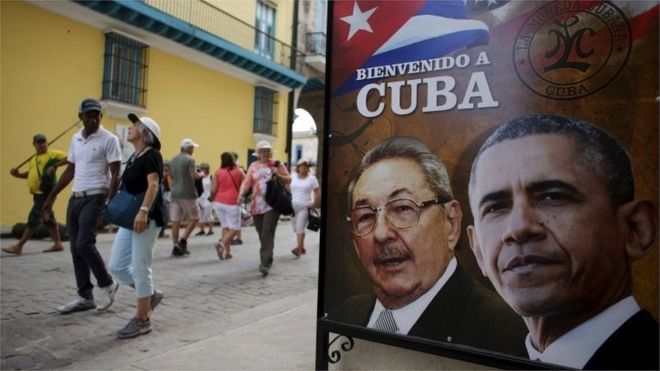Barack Obama to meet Raul Castro on historic visit

President Barack Obama will make history on Sunday when he flies to Cuba to visit the island and hold talks with its communist leader.
The two-day visit will be the first by a sitting US president since Calvin Coolidge went 88 years ago.
Mr Obama will meet President Raul Castro — but not retired revolutionary leader Fidel Castro — and the pair will discuss trade and political reform.
Protesters were arrested in the capital Havana hours before Mr Obama's arrival.
Police took away dozens of demonstrators from the Ladies in White group, formed by wives of political prisoners, from outside a church where they attempt to hold weekly protests.
Correspondents say the visit marks a huge turnaround in US-Cuban relations.
It is hard to overstate the significance of this trip because as recently as 18 months ago, the idea of a US president stepping foot on Cuban soil would have been unthinkable, the BBC's North America editor Jon Sopel says.
But when Air Force One touches down in Havana on Sunday evening it will represent the opening of a new chapter in the affairs of the two nations, our correspondent says.
Mr Obama and Raul Castro will sit together at a state dinner, there will be a joint news conference and they will discuss trade.
The White House has made it clear President Obama will meet political dissidents, whether the Cuban authorities like it or not. That is expected to include members of the Ladies in White group, wives of political prisoners.
Economic sanctions
This visit does not mark a complete normalisation in relations, however.
The 54-year-old US economic embargo of Cuba is still in place and can only be lifted by a vote in Congress. Meanwhile, Cuba still complains about the occupation of the US naval base at Guantanamo Bay.
Nevertheless enormous strides have already been taken, our correspondent says.
Mr Obama and Mr Castro agreed in December 2014 to end decades of frozen relations that began when Cuba's revolution overthrew a pro-US government in 1959.
Since 2014 there have been commercial deals on telecoms and a scheduled airline service, increased co-operation on law enforcement and environmental protection.
On Wednesday Mr Obama sent a letter on the first direct mail flight from the US to Cuba since the revolution.
And on Sunday, US hotel company Starwood become the first American firm to agree a deal with the Cuban authorities since 1959.
The US president is not scheduled to meet the man who led the revolution — Fidel Castro — but Cubans were reminded of their historic leader on Sunday as newspapers published pictures of him meeting Venezuela's Nicolas Maduro.
Analysts suggested the release of the pictures underlines conflicting sentiments within the Communist party over hosting Mr Obama.
Fidel Castro meets with Venezuelan President Nicolas Maduro
US-Cuba relations were frozen since the early 1960s, when the US broke off diplomatic relations and imposed a trade embargo after Cuba's revolution led to communism.
The embargo was estimated to cost the US economy $1.2bn a year.
US President Barack Obama announced moves to normalise diplomatic and economic ties in December 2014.
It followed more than a year of secret talks in Canada and at the Vatican, directly involving Pope Francis.
The plans included reviewing the designation of Cuba as a state sponsor of terrorism, easing a travel ban for US citizens, easing financial restrictions, increasing telecommunications links as well as efforts to lift the trade embargo.
The US reopened its embassy in Havana in August 2015, a month after Cuba reopened its embassy in Washington.
Политика конфиденциальности | Правила пользования сайтом









